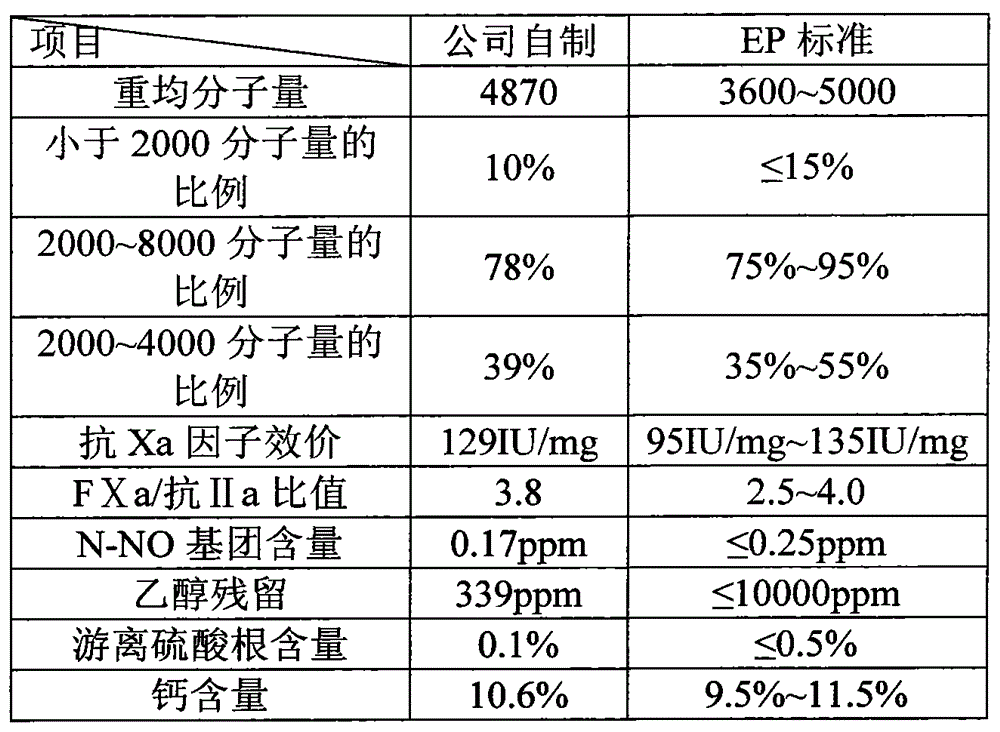Preparation process of nadroparin calcium
A preparation technology of nadroparin calcium, which is applied in the preparation technology of high-quality nadroparin calcium and the field of preparation of medicinal chemicals, can solve the problems of low yield, low degree of automation, and high cost of separation methods, and achieve operational Convenience, high degree of automation, and the effect of improving production capacity
- Summary
- Abstract
- Description
- Claims
- Application Information
AI Technical Summary
Problems solved by technology
Method used
Image
Examples
Embodiment 1
[0022] Example 1: Preparation of Nadroparin Calcium
[0023] Degradation of heparin sodium: feed 30kg heparin sodium, dissolve it in purified water with 21 to 30 times the weight of heparin sodium, adjust pH to 5.5 to 6, add 4.5% to 5% of sodium nitrite, and keep at 10°C to 30°C. The degraded solution was stirred for 3 to 6 hours.
[0024] Reduction of the degradation solution: adjust the pH of the degradation solution to neutrality, add 1.5% to 2% of sodium borohydride of the heparin sodium feeding amount, and stir and react at 10°C to 30°C for 12 to 24 hours to obtain a degradation reduction solution.
[0025] Ultraviolet irradiation: 254nm wavelength ultraviolet lamp is inserted into the reducing solution and irradiated for 45 to 90 minutes at room temperature to eliminate the residual nitroso compounds in the solution and reduce the content of N-NO groups.
[0026] Calcium transfer and concentration: The reducing solution is ultrafiltered with a 5% calcium chloride soluti...
Embodiment 2
[0029] Example 2: Preparation of Nadroparin Calcium
[0030] Degradation of heparin sodium: feed 30kg heparin sodium, dissolve in purified water with 15 to 20 times the weight of heparin sodium, adjust the pH to 4.5, add 2% to 2.3% of sodium nitrite in the feeding amount, keep the temperature at 15°C to 30°C and stir the reaction 3 to 6 hours of degradation solution.
[0031] Reduction of the degradation solution: adjust the pH of the degradation solution to neutrality, add 0.6% to 1% of sodium borohydride of the heparin sodium feeding amount, and stir and react at 15°C to 20°C for 12 to 24 hours to obtain a degradation reduction solution.
[0032] Ultraviolet irradiation: 254nm wavelength ultraviolet lamp is inserted into the reducing solution and irradiated for 45 to 90 minutes at room temperature to eliminate the residual nitroso compounds in the solution and reduce the content of N-NO groups.
[0033] Calcium transfer and concentration: The reducing solution is ultrafilte...
Embodiment 3
[0036] Example 3: Preparation of Nadroparin Calcium
[0037] Degradation of heparin sodium: feed 30kg heparin sodium, dissolve it in purified water with 10 to 14 times the weight of heparin sodium, adjust pH to 5, add 3% to 4% of sodium nitrite in the feeding amount, keep at 20°C to 30°C and stir the reaction 3 to 6 hours of degradation solution.
[0038] Reduction of the degradation solution: adjust the pH of the degradation solution to neutrality, add 0.5% to 0.8% of sodium borohydride of the heparin sodium feeding amount, and stir and react at 10°C to 30°C for 12 to 24 hours to obtain a degradation reduction solution.
[0039] Ultraviolet irradiation: 254nm wavelength ultraviolet lamp is inserted into the reducing solution and irradiated for 45 to 90 minutes at room temperature to eliminate the residual nitroso compounds in the solution and reduce the content of N-NO groups.
[0040] Calcium transfer and concentration: The reducing solution is ultrafiltered with 17-20 time...
PUM
 Login to View More
Login to View More Abstract
Description
Claims
Application Information
 Login to View More
Login to View More - R&D
- Intellectual Property
- Life Sciences
- Materials
- Tech Scout
- Unparalleled Data Quality
- Higher Quality Content
- 60% Fewer Hallucinations
Browse by: Latest US Patents, China's latest patents, Technical Efficacy Thesaurus, Application Domain, Technology Topic, Popular Technical Reports.
© 2025 PatSnap. All rights reserved.Legal|Privacy policy|Modern Slavery Act Transparency Statement|Sitemap|About US| Contact US: help@patsnap.com

